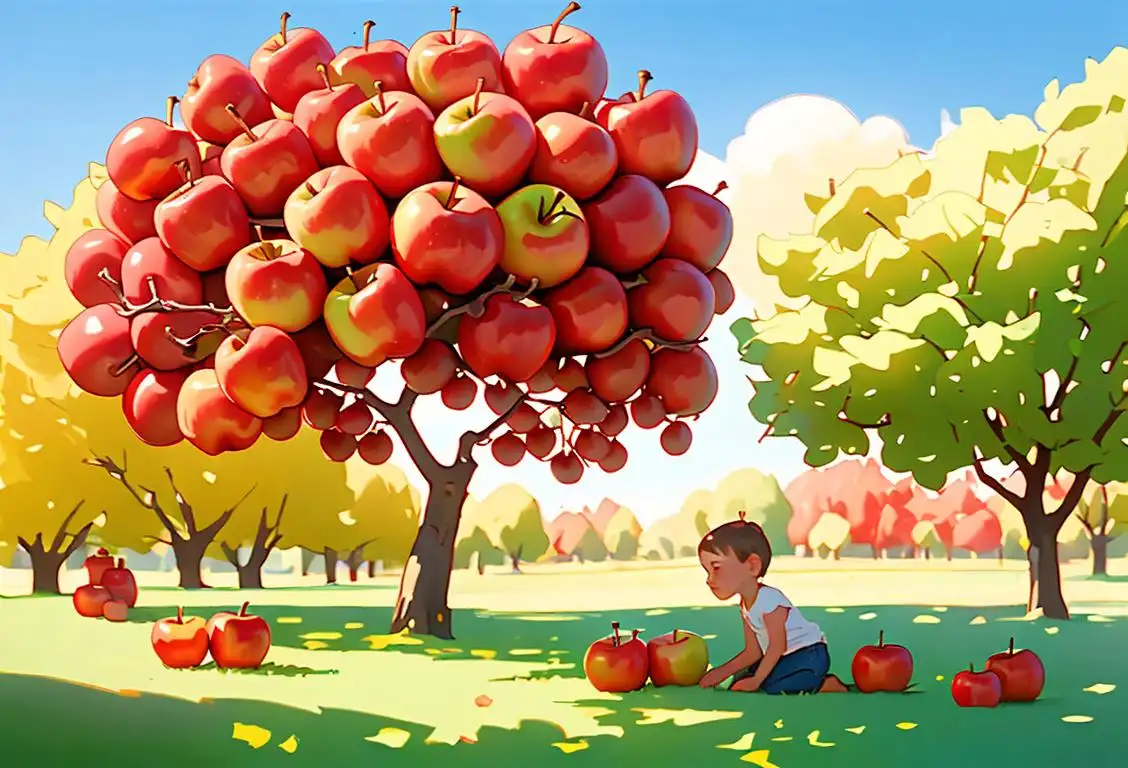National Apple Tree Day

Ah, National Apple Tree Day! Let's branch out and learn about this delightful celebration of our fruity friends.
When is Apple Tree Day?
It's national apple tree day on the 6th January.
From Seeds to Cider: The Journey of National Apple Tree Day
Every year on National Apple Tree Day, we come together to appreciate the wonders of apple trees and all they provide. So, grab a bushel of apples and get ready for an apple-tastic adventure!
This special day is all about celebrating these magnificent fruit-bearing beauties and the role they play in our lives. Whether it's the crisp first bite of a juicy apple or the sweet aroma of freshly baked apple pie, apples bring us a joyful taste of nature's goodness.
Apple trees have a rich history that's deeply rooted in human culture. They have been around for thousands of years and have been grown and nurtured by countless generations. These trees offer us shade on hot summer days, beautiful blossoms in the spring, and bountiful harvests in the fall. Plus, let's not forget the cider! Apple trees are like nature's gift that keeps on giving.
A Crispy Connection with Johnny Appleseed
No discussion of apple trees would be complete without mentioning the legendary Johnny Appleseed. Born as John Chapman, Johnny Appleseed was an American pioneer nurseryman who traveled extensively, planting apple trees across the country in the late 18th and early 19th centuries. He believed in spreading the joy and bounty of apple trees, and his efforts helped establish orchards across several states.
Although his story is often embellished with folk tales and legends, Johnny Appleseed's passion for apple trees and his ecological contributions cannot be denied. He sowed the seeds of countless apple trees, leaving a delicious legacy for generations to come. So, raise your apple-filled mugs to Johnny Appleseed on this wonderful day!
An Orchard of Fun
Now that we've explored the historical significance of apple trees, it's time to sprinkle some fun into the mix! Here's a did-you-know fact to keep you entertained:
Did you know that the ancestor of the modern apple tree originated in Kazakhstan? Yes, you read that right! Apples have come a long way from their humble beginnings in Central Asia to your fruit bowl. Thank you, ancient apple trees, for your delicious gift.
So, whether you're devouring a crisp apple straight from the tree or sipping on a glass of refreshing apple cider, make sure to pause and appreciate the wonder of apple trees on this delightful National Apple Tree Day. Happy apple picking, everyone!
History behind the term 'Apple Tree'
8,000 BCE
The Ancient Roots
The history of the term 'apple tree' traces back to approximately 8,000 BCE, when the cultivation of apple trees began in the fertile lands of Central Asia. It is believed that wild apple trees originated in the mountainous regions of present-day Kazakhstan. The wild apple trees served as an important food source for early hunter-gatherer communities, and their cultivation marked the beginning of a long-standing relationship between humans and apple trees.
8000 BCE
Discovery of Wild Apple Trees
In 8000 BCE, hunter-gatherers in the Tien Shan mountains of Kazakhstan discovered wild apple trees. These ancient fruit trees, known as Malus sieversii, are the ancestors of modern-day cultivated apple trees. The hunter-gatherers were likely drawn to the delicious and nutritious fruits, marking the first interaction between humans and apple trees.
12th century
Introduction of the term 'apple tree'
The term 'apple tree' originated in the 12th century. It combines the word 'apple,' which dates back to Old English and refers to the fruit of the Rosaceae family, with the word 'tree,' which has roots in various ancient languages such as Old English, Old Norse, and Old High German. The term 'apple tree' specifically denotes a type of tree that belongs to the Malus genus and produces apples as its fruit.
15th century
The emergence of 'apple tree'
The term 'apple tree' originated in the 15th century as a way to describe the fruit-bearing tree belonging to the Malus domestica species. The word 'apple' can be traced back to Old English 'æppel,' which itself was derived from the Proto-Germanic word 'aplaz.' The term 'tree' comes from Old English 'trēow,' which meant 'wood' or 'beam.' As apple trees became increasingly cultivated and grown during this time, the term 'apple tree' gained popularity as a way to refer to these specific trees.
4000 BCE
The Earliest Records
The term 'apple tree' can be traced back to around 4000 BCE, where it is mentioned in the ancient writings of Mesopotamia. These texts describe the cultivation and importance of apple trees in the fertile lands between the Tigris and Euphrates rivers. The Mesopotamians regarded the apple tree as a symbol of beauty, fertility, and abundance.
5000 BCE
Cultivation of Apple Trees
Around 5000 BCE, people in Mesopotamia, present-day Iraq, started actively cultivating apple trees. They recognized the potential of apple trees as a valuable food source and began cultivating them for consumption and trade. The apples they grew were smaller and more bitter than the ones we know today but still highly prized.
1668
Recognition of the apple tree's role in science
In 1668, Sir Isaac Newton, the renowned physicist, made a significant discovery while sitting under an apple tree. According to the legend, Newton was struck by an apple falling from a tree, which led him to formulate the theory of gravity. This event solidified the apple tree's place in scientific history and further popularized its association with knowledge and discovery.
1300 BCE
Apple Tree in Mythology
In ancient Greek mythology, the term 'apple tree' gained further significance. The Greek goddess of discord, Eris, threw a golden apple inscribed with the words 'To the Fairest' into a banquet attended by the gods and goddesses. This act sparked a competition among three goddesses, eventually resulting in the Trojan War. The apple tree became a representation of strife, temptation, and the consequences of jealousy.
3,000 BCE
The Ancient Symbolism
By 3,000 BCE, apple trees had gained significant symbolic importance in various ancient cultures. In Mesopotamia, apple trees were associated with fertility and considered sacred to the goddess Ishtar. In ancient Greece, the apple tree was revered as a symbol of love and beauty and was associated with the goddess Aphrodite. It is noteworthy that in both these cultures, the term 'apple tree' also became associated with concepts beyond the literal tree itself.
16th century
Cultural symbolism of apple trees
During the 16th century, apple trees gained cultural symbolism in various parts of the world. They were often associated with concepts such as fertility, abundance, and temptation. In Christian tradition, apple trees were connected to the biblical story of Adam and Eve, where the apple from the Tree of Knowledge was believed to have led to their expulsion from the Garden of Eden.
19th century
Cultural symbolism of the apple tree
During the 19th century, the apple tree began to take on cultural symbolism across various societies. In Western cultures, it became associated with concepts such as knowledge, temptation, and the biblical story of Adam and Eve. The apple tree's role in mythology and folklore further enhanced its significance, with representations in tales like 'Snow White' and 'William Tell.' This cultural symbolism solidified the apple tree's place in art, literature, and popular culture.
55 BCE
Apple Trees Reach Britain
In 55 BCE, Roman troops led by Julius Caesar brought apple trees to Britain. The Romans appreciated the taste and versatility of apples and introduced them to the region during their conquest. This marked the introduction of apple trees to what would later become known for its apple orchards and cider production.
1660
The British Orchard
The term 'apple tree' made its way to British shores around the year 1660 when King Charles II returned from exile in France. During his time in France, he became fascinated by the apple orchards and brought back several varieties of apple trees to England. This marked the beginning of organized apple tree cultivation in the country. Soon, it became common to refer to trees bearing apples as 'apple trees' in England and the British colonies.
18th century
Apple tree cultivation in North America
In the 18th century, apple trees were widely cultivated in North America. European settlers brought apple tree saplings with them to the New World, establishing orchards throughout the region. These orchards played a crucial role in providing a sustainable source of food and cider to early American communities.
1668
Bringing Apples to North America
The term 'apple tree' made its way to North America with English colonists in the 17th century. The settlers recognized the value of apple trees for their fruits and began cultivating them, establishing orchards throughout the New World. These colonial orchards laid the foundation for the apple industry that would later flourish in the United States.
19th century
Apple tree domestication and breeding
During the 19th century, apple tree domestication and breeding efforts were intensified. As a result, numerous apple varieties were created, each with its unique characteristics, flavors, and uses. Prominent figures such as Johnny Appleseed (John Chapman) contributed to the expansion of apple tree cultivation across the United States.
1620
Apple Trees Arrive in North America
During the colonization of North America, European settlers brought apple tree saplings with them. The Pilgrims aboard the Mayflower carried apple seeds and saplings to establish orchards in the New World. This momentous event set the stage for apple trees to become an essential part of American agriculture and culinary tradition.
1847
The Discovery of Apple Tree Genetics
In 1847, a figure named Hermann J. Muller discovered how apple trees reproduce through cross-pollination and the transmission of genetic traits. This breakthrough in understanding the genetics of apple trees allowed for intentional cross-breeding, leading to the development of new and improved apple varieties with desirable traits such as taste, texture, and resistance to diseases.
20th century
Apple trees in horticulture and agriculture
In the 20th century, apple trees became integral to horticulture and agriculture. Cultivated apple varieties were bred, and orchards dedicated to apple tree cultivation became commonplace. The term 'apple tree' gained importance not only in terms of its cultural significance but also as an essential crop contributing to food production around the world. The apple tree's ability to adapt to different climates and bear fruit abundantly made it a highly valued and sought-after tree in orchards.
1851
Johnny Appleseed's Legacy
The term 'apple tree' gained further popularity in the 19th century, thanks to the legendary figure of Johnny Appleseed. Born as John Chapman, Johnny Appleseed was an American pioneer nurseryman who traveled extensively across the United States, planting apple trees as he went. His efforts to promote apple tree cultivation not only led to the expansion of apple orchards but also popularized the term 'apple tree' in American culture.
20th century
Apple tree commercialization and global popularity
In the 20th century, apple trees became highly commercialized due to increasing demand and technological advancements. Orchards, both large-scale and small-scale, flourished around the world. Apples became one of the most popular and widely consumed fruits globally, not only as a fresh snack but also in various processed forms like apple sauce, cider, and pies.
Today
The Cultural Symbol
In modern times, the term 'apple tree' has become deeply ingrained in our cultural consciousness. It symbolizes various concepts such as fertility, knowledge, temptation, health, and the cycle of life. From the biblical story of Adam and Eve to the famous apple-related anecdotes in the lives of Sir Isaac Newton and Steve Jobs, apple trees continue to capture our imagination and hold a special place in our collective symbolism.
1977
Birth of the Apple Computer
In 1977, the term 'apple tree' took on a whole new meaning in the world of technology. Steve Jobs and Steve Wozniak co-founded Apple Computer, Inc., utilizing the term 'apple' as a symbol of simplicity, creativity, and accessibility. The Apple logo, an apple with a bite taken out of it, soon became one of the most recognized and iconic corporate symbols in the world.
1811
Discovery of a New Apple Variety: Granny Smith
In 1811, Maria Ann Smith, also known as Granny Smith, accidentally discovered a new apple variety in Australia. While disposing of some French crab apples, she noticed a seedling growing. This chance apple tree eventually produced the delicious, tart Granny Smith apple, which is now celebrated for its use in baking and as a crisp snack.
1870
Beginning of Commercial Apple Production
In the late 19th century, commercial apple production took off in the United States. Improved transportation infrastructure, including railroads, enabled apples to be shipped to different regions, making them widely available to consumers. This era marked the transition from predominantly subsistence orchards to large-scale apple cultivation for the market.
1922
Apple Varieties Standardization
In 1922, the American Apple Association (now the U.S. Apple Association) was formed to standardize apple varieties and improve marketing. This initiative aimed to promote a consistent apple quality and provide consumers with clear labeling. Standardization played a crucial role in establishing apples as one of the most popular fruits worldwide.
1991
World Apple Production Reaches 50 Million Tons
By 1991, global apple production reached a significant milestone, surpassing 50 million tons for the first time. This exemplifies the enduring popularity and global demand for this beloved fruit. The diverse range of apple varieties, flavors, and culinary applications has made apples an agricultural success story on a massive scale.
Did you know?
Did you know that the ancestor of the modern apple tree originated in Kazakhstan?Tagged
food fun historyFirst identified
6th January 2017Most mentioned on
6th January 2017Total mentions
23Other days
Senior Citizens Day
French Fries Day
Hot Chocolate Day
Lasagna Day
Jelly Bean Day
Chili Day
Nacho Day
Vodka Day
Martini Day
Pastry Day









